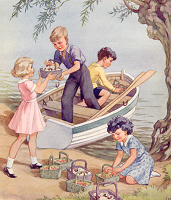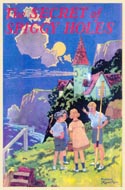
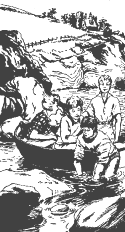
It's great fun playing in the rock pools at down at Spiggy Holes.

The children watch and listen... and then the motor boat speeds off.
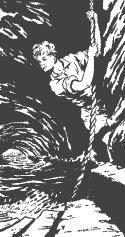
Jack is trapped by the rising tide water!
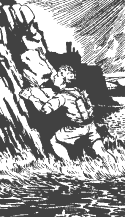
Escaping to safety by clambering up the rocks.
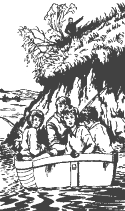
The children think they're safe on the secret island. But then Paul warns them of a boat coming!
The Secret of Spiggy Holes
Review by Keith Robinson (April 7, 2006)
A worthy follow up to the excellent 1938 novel, The Secret Island, this new adventure takes Jack, Mike, Nora and Peggy to the coast of Cornwall, specifically a little place called Spiggy Holes. While Captain and Mrs Arnold are on a lecture tour in Ireland, the children are, in true Blyton fashion, fobbed off on a kindly host with tons of food in the larder. In this case the kindly host is Miss Dimity, or Dimmy as the children affectionately nickname her, and she's a good sort all right—not a harsh word to say about any of them, and able to turn a blind eye to whatever mischief the children are up to, day and night!
Spiggy Holes is about forty miles from their dear old secret island, which lies on Lake Wildwater, and the children arrive by express train from some unknown place. Apparently it's not all that important to know where the children actually live, and up until reading this opening chapter I had assumed their home was somewhere in the vicinity of the secret island. But my initial impression was wrong; it seems they live somewhere inland, miles and miles away.
Anyway, upon arrival at Spiggy Holes, the children find the house a very interesting place indeed. It's called Peep-Hole, and has a tower with windows all around. The boys are to stay in the topmost room, while the girls are in the room below. Across the cliff lies another house, called simply Old House, and this too has a tower that overlooks the sea. Cue stories of smugglers and signals from the tower in the dead of night... Actually, since this book was written in 1940, you could say this was one of Blyton's first, if not the first, to feature such familiar themes. Other familiar themes to pop up in this book include a kidnapping; a prisoner in a tower; an ill king from some made-up foreign country, and whose son, the prince, is in danger and must be hidden away by the children; endless secret tunnels between houses and leading down to caves on the beach; a rope tied around the waist of a local lad, who always carries one just in case; and of course lashings of food!
All these themes may seem overly familiar and therefore tired, even despite the fact that this book precedes the Famous Five and Adventure books, but somehow The Secret of Spiggy Holes is still an exciting and fun read. At first Jack takes a back seat, as thrilled as the others at being near the sea. The "local help," George, is a good sport and takes them out in his boat, but most other times the children are either bathing or paddling about in the shallow pools on the rocks. A wonderful holiday all round! But then things start to happen, and Jack must take charge once more...
The Old House on the cliff is a desolate place, with a garden that's badly overgrown. But as the children are exploring it one day, grown-ups arrive—sinister foreigners who talk of the Old House being "the very place," and "nobody would ever guess." The foreigners are a Mr Felipe Diaz and his yellow-haired wife (who incidentally plays no part in this story other than showing her face in this scene), and later a man called Luiz. They buy the old place, and immediately set about trying to buy Dimmy's house too. She refuses, and the foreigners get angry. "Then let us rent the place for twelve months," Mr Diaz suggests, but Dimmy is having none of it, and that's that.
Curious about what the strange, unfriendly people are up to, the children hide up a tree outside the Old House. Naturally Mr Diaz and Luiz come sauntering by and, eavesdropping, the children overhear talk of signalling to a boat from the tower—just like smugglers of old, laughs Mr Diaz, "only our goods will not quite be the same."
I didn't think much of it at first, but in retrospect I have to question why Mr Diaz goes to so much trouble to buy a house with a tower on a cliff just so he can light a signal and allow a boat to come in to shore with "the goods." I mean, really, it seems like such a lot of trouble to go to—buying the property, fixing some of it up, bringing in furniture, etc, when all along they planned to leave by the end of the book!
"The goods" arrive late one night. The children have been taking turns to watch, and sure enough, there's that signal from the tower. The children rush down to the shore in time to see a boat come in. They hide in a cave, and listen as Mr Diaz and Luiz meet the boat crew... and then the boat leaves, and the foreigners disappear into a cave. Where did they go? After half an hour the children realize the foreigners must have left by some other route, and they head back to Peep-Hole, excited by the night's events, but puzzled by the strangers' disappearing act.
An exploration of the caves follows the next day, and the children find a secret passage that leads to the Old House! So that's where Mr Diaz and Luiz disappeared to, along with "the goods," whatever they were. Jack finds a way that leads into the Old House's scullery, and he ends up scooting up the steps of the tower—only to find a locked door at the top. From behind the door comes the sound of crying.
This is Prince Paul's introduction to the series. He's a prince from the country of Baronia, kidnapped while his father falls ill. If the king dies, he explains through the door to Jack, and the prince cannot be found, then the enemy will take over the throne. The prince must be rescued at once, and Jack, Mike, Peggy and Nora set about devising a scheme to get Paul out of the tower. What follows is all very readable and fun, and very much Blyton in her element. This series is a cross between the Adventure books and the Famous Five; each has their share of secret passages, caves, prisoners locked in towers, and plenty of meals along the way. Prince Paul isn't half as interesting a character as Gus from The Circus of Adventure, though; here, Paul is quiet and a bit of a wimp. He's nice, but boring.
Something that bothered me in this book are the actions of the villains when they nab Mike during the children's daring attempt to rescue Paul. The evil foreigners go about their business as normal, telling Mike that he'll just have to stay locked up until Friday, when they plan to move Paul to some other place less crowded with children. This strikes me as a very casual attitude. Surely they realize that if one of the four children is there, trying to rescue Paul, then the other three must be somewhere close by? What if they go to the police?
Without wanting to spoil the end, the book eventually takes us back to the secret island—a very welcome turn of events! But of course that idea goes pear-shaped when the villains follow them...
Overall, a very good follow-up to The Secret Island.
The Secret of Spiggy Holes
Review by Laura Canning (July 6, 2006)Again I reread this recently, not remembering anything about it from reading it as a child. This is an excellent sequel to The Secret Island, although a bit heavy on the secret passage/smugglers/rescue effort of later books. (Although, as Keith says, this was one of the earliest Blyton books so maybe the first time she used these devices. Still, they are a bit tedious after reading 21 Famous Fives!). Again we have the children on their own, with plenty of delicious food and no interfering adults. Dimmy, who is looking after them while their parents are in Ireland, is first class—when the baddies come to Peep-Hole to complain about the children being in the grounds of their house, Dimmy replies coldly that the children are 'not bad-mannered' as the villain says, and that anyway, they didn't know the house was occupied when they went exploring. Hurrah!
It did jar a bit why the villains chose their house in the first place. If they were planning to kidnap a prince and so needed complete secrecy, surely demanding that Dimmy sell them Peep-Hole, and then asking fisher boy George about the comings and goings of the coast, would arouse the suspicions of even non-Blytonlike children. And why, when they capture Mike, do they decide to keep both him and Paul there for another few days? Of course they would assume the children would go to the police. Dimmy, for all her jolly-good-sortedness, is also a pretty irresponsible guardian when the children finally tell her what's going on—joining in the rescue effort by trying to find another secret passage (yawn), instead of telling the police.
And how did the baddies get back to their house without the children seeing them from the beach? Why, another secret passage, of course. I was practically yelling this at the book at this point, while the children were standing there trying to puzzle it out.
Still, another action-packed adventure, like the rest of the series, and definitely superior to one or two of the later ones. Sadly we now have Prince Paul for the rest of the ride. He's okay in this book but an awful pain in the later ones...


